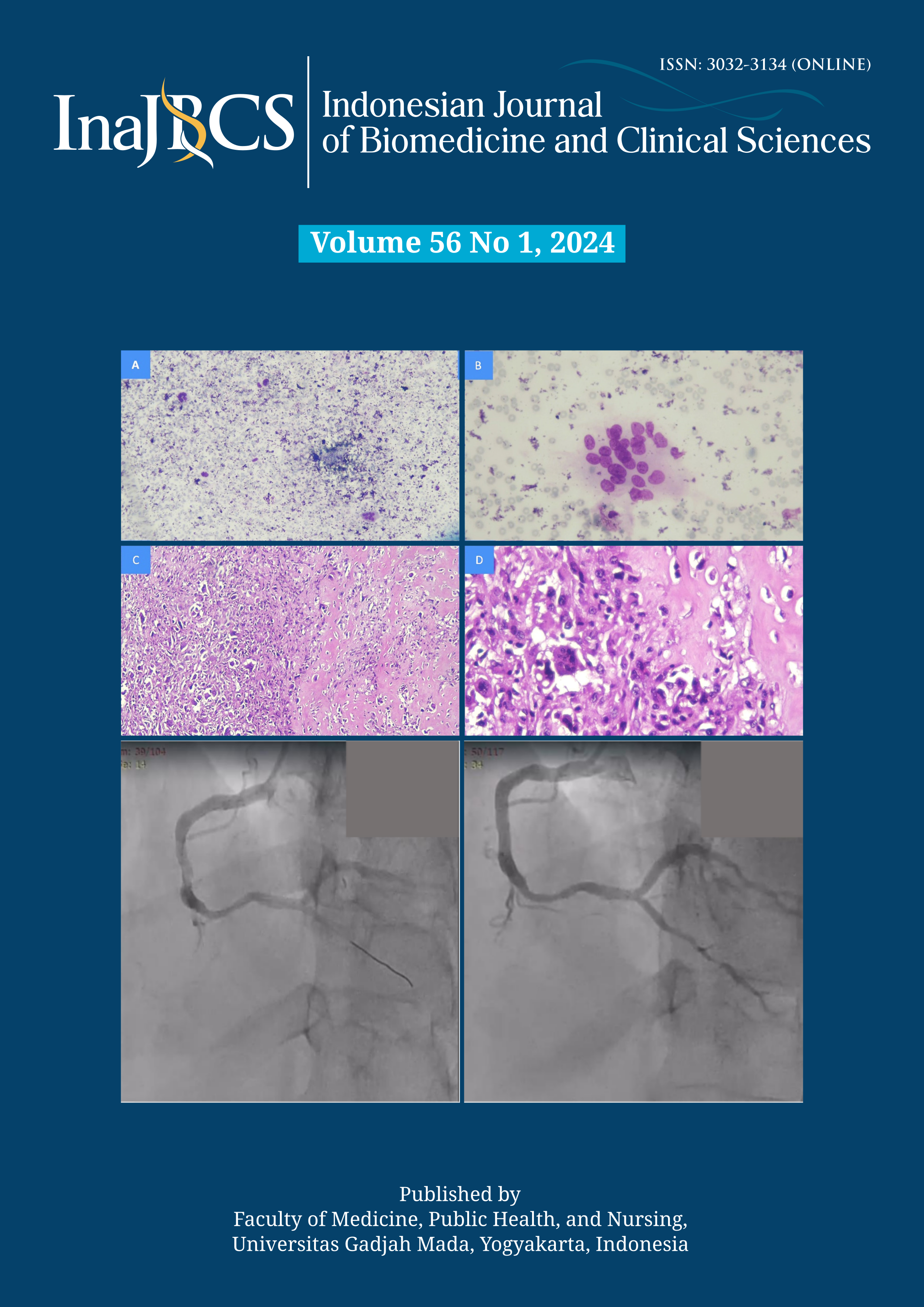The correlation between interleukin-4 (IL-4) and programmed cell death-ligand 2 (PD-L2) expression with clinicopathological characteristics on prostate cancer
Abstract
Prostate cancer (PCa) is the most frequent cancer diagnosed worldwide and the second most common malignancy in men. IL-4 is one of cytokines related to the inflammation process. An increase level of IL-4 in patients with PCa might be related to progression to castrate-resistance prostate cancer. Programmed
cell death-ligand 2 (PD-L2) plays an important role in the anti-tumor immune system, however the exact mechanism is not fully understood. This study aimed to investigate the correlation between IL-4 and PD-L2 expression with the clinicopathological characteristic of PCa. The IL-4 and PD-L2 examinations were
performed using quantitative real-time polymerase chain reaction (qRT-PCR) while clinicopathological characteristics were described by the Gleason score and International Society of Urological Pathology (ISUP) grade. Data collected were then analyzed using Pearson and Spearman test. In total, 20 patients with
PCa tissue were collected between 2015 and 2020. The mean level of IL-4 and PDL2 were higher in metastatic PCa/M-PCa (105.64 and 665.42 ng/mL) compared to non-metastatic PCa/NM-PCa (41.62 and 215.06 ng/mL). A significant difference with medium correlation between IL-4 and PD-L2 with Gleason score and ISUP
grade was observed on all samples (p = 0.035 and 0.045; r = 0.454 and 0.473). However, no significant difference with weak correlation was observed on each group (p = 0.136 and 0.858; r = 0.065 and 0.506). Interestingly, there was a significant difference with very strong correlation observed between IL-4 and
PD-L2, both on all samples (p = 0.001; r = 0.955) and on each group (p = 0.001 and 0.001; r = 0.917 and 0.955). In conclusion, there is a correlation between IL-4 and PD-L2 with the clinicopathological characteristics of PCa.
References
Center MM, Jemal A, Lortet-Tieulent J,Ward E, Ferlay J, Brawley O, et al. International variation in prostate cancer incidence and mortality rates. Eur Urol 2012; 61(6):1079-92.
https://doi.org/10.1016/j.eururo.2012.02.054
Bray F, Piñeros M. Cancer patterns, trends and projections in latin america and the caribbean: A global context. Salud Publica Mex 2016; 58(2):104-17.
https://doi.org/10.21149/spm.v58i2.7779
Wong MCS, Goggins WB, Wang HHX, Fung FDH, Leung C, Wong SYS, et al. Global Incidence and Mortality for Prostate Cancer: Analysis of Temporal Patterns and Trends in 36 Countries. Eur Urol 2016; 70(5):862-74.
https://doi.org/10.1016/j.eururo.2016.05.043
Brawley OW. Trends in prostate cancer in the United States. J Natl Cancer Inst Monogr 2012; (45):152-6.
https://doi.org/10.1093/jncimonographs/lgs035
Goldstein R, Hanley C, Morris J, Cahil D, Chandra A, Harper P, et al. Clinical investigation of the role of interleukin-4 and interleukin-13 in the evolution of prostate cancer. Cancers 2011; 3(4):4281-93.
https://doi.org/10.3390/cancers3044281
Tindall EA, Severi G, Hoang HN, Fernandez P, Southey MC, English DR, et al. Comprehensive analysis of the cytokine-rich chromosome 5q31.1 region suggests a role for IL-4 gene variants in prostate cancer risk. Carcinogenesis 2010; 31(10):1748-54.
https://doi.org/10.1093/carcin/bgq081
Setrerrahmane S, Xu H. Tumor-related interleukins: old validated targets for new anti-cancer drug development. Molecular Cancer 2017; 16(1):153.
https://doi.org/10.1186/s12943-017-0721-9
Takeshi U, Sadar MD, Suzuki H, Akakura K, Sakamoto S, Shimbo M, et al. Interleukin-4 in patients with prostate cancer. Anticancer Res 2005; 25(6C):4595-98.
Gooch JL, Lee AV, Yee D. Interleukin 4 inhibits growth and induces apoptosis in human breast cancer cells. Cancer Res 1998; 58(18):4199-205.
Toi M, Bicknell R, Harris AL. Inhibition of colon and breast carcinoma cell growth by interleukin-4. Cancer Res 1992;52(2):275-9.
Vuletić AM, Konjević GM, Larsen AK, Babović NL, Jurišić VB, et al. Interleukin-4-induced natural killer cell antitumor activity in metastatic melanoma patients. Eur Cytokine Netw 2020; 3.
https://doi.org/10.1684/ecn.2020.0449
Solinas C, Aiello M, Rozali E, Lambertini M, Willard-Gallo K, Migliori E. Programmed cell death-ligand 2: a neglected but important target in the immune response to cancer? Transl Oncol 2020; 13(20):100811.
https://doi.org/10.1016/j.tranon.2020.100811
Zhao SG, Lehrer J, Chang SL, Das R, Erho N, Liu Y, et al. The immune landscape of prostate cancer and nomination of PD-L2 as a potential therapeutic target. J Natl Cancer Inst 2019; 111(3):301-10.
https://doi.org/10.1093/jnci/djy141
Zhang T, Agarwal A, Almquist RG, Runyambo D, Park S, Bronson E, et al. Expression of immune checkpoints on circulating tumor cells in men with metastatic prostate cancer. Biomark Res 2021; 9(1):14.
https://doi.org/10.1186/s40364-021-00267-y
Gleason DF. Classification of prostatic carcinomas. Cancer Chemother Rep 1966; 50(3):125-28.
Erb HHH, Culig Z, Stope MB. IL-4 counteracts the cytotoxic effects of peripheral Blood mononuclear cells on hormone-sensitive prostate cancer cells. In Vivo 2021; 35(4):1973-77.
https://doi.org/10.21873/invivo.12465
Zhao SG, Lehrer J, Chang SL, Das R, Erho N, Liu Y, et al. The immune landscape of prostate cancer and nomination of PD-L2 as a potential therapeutic target. J Natl Cancer Inst 2019; 111(3):301-10.






